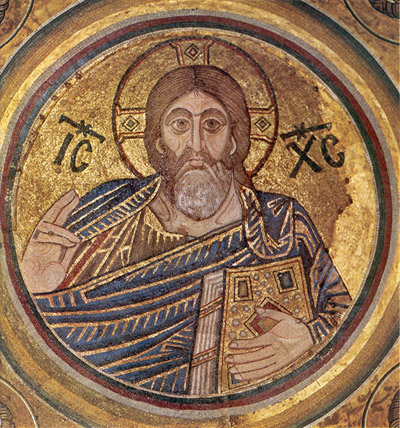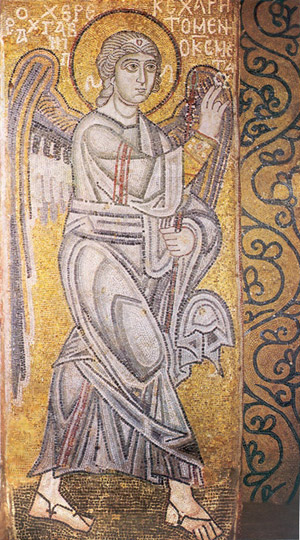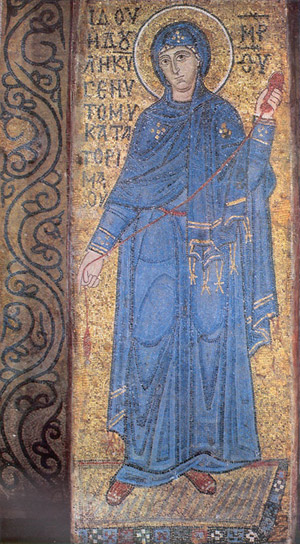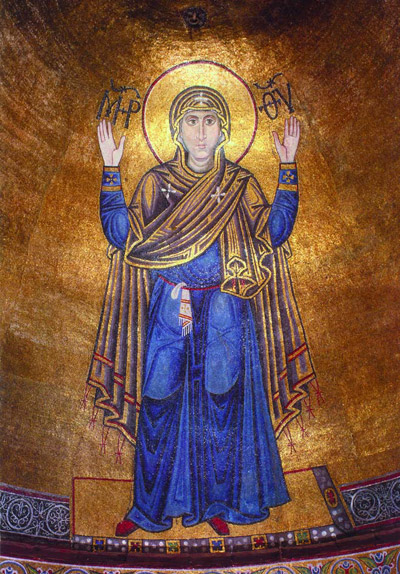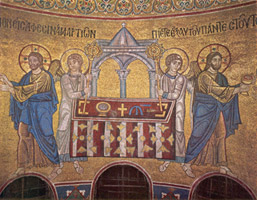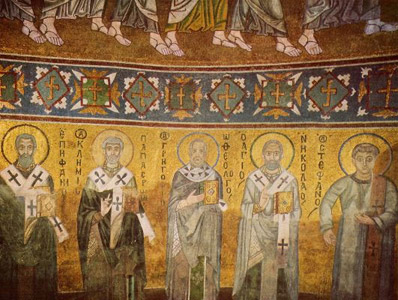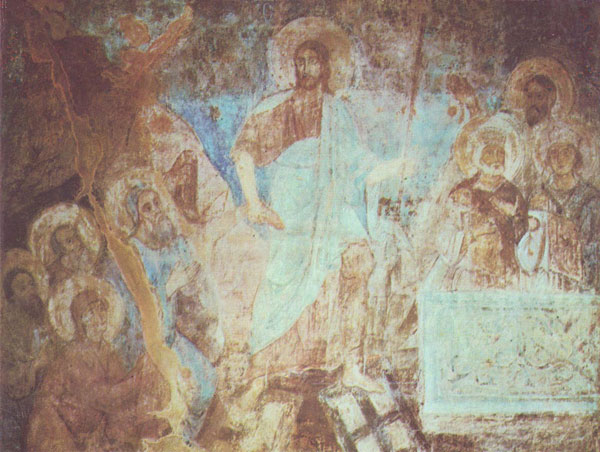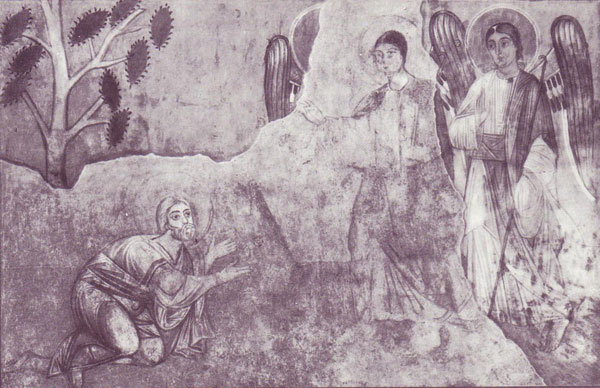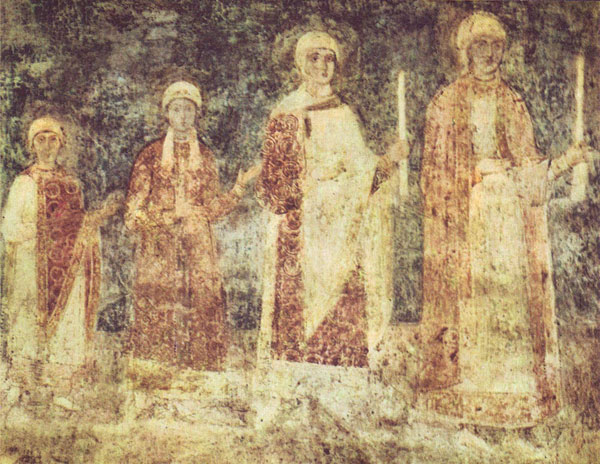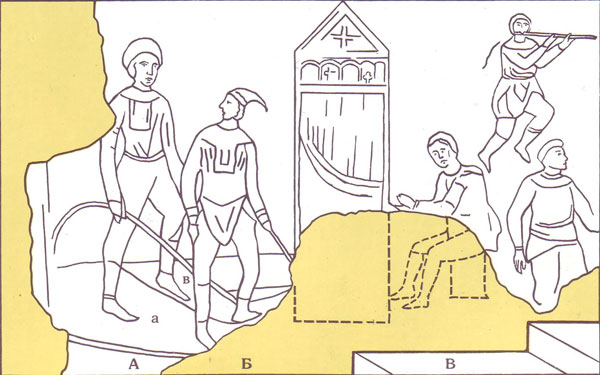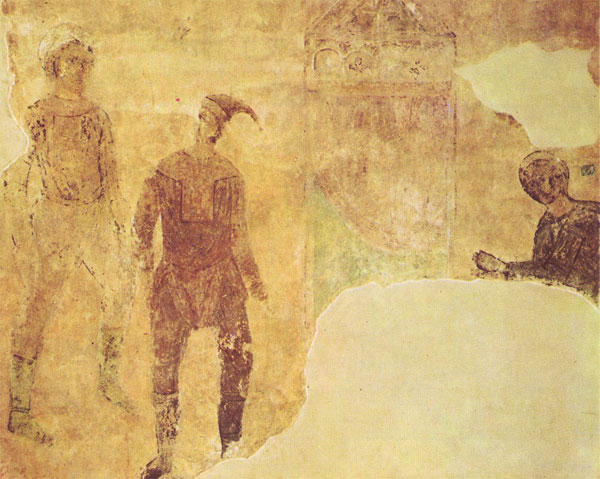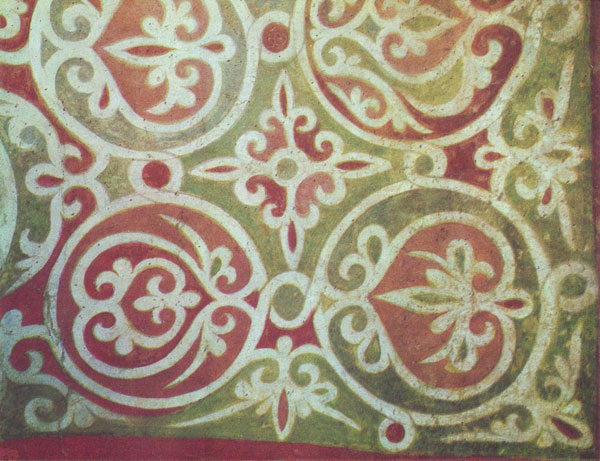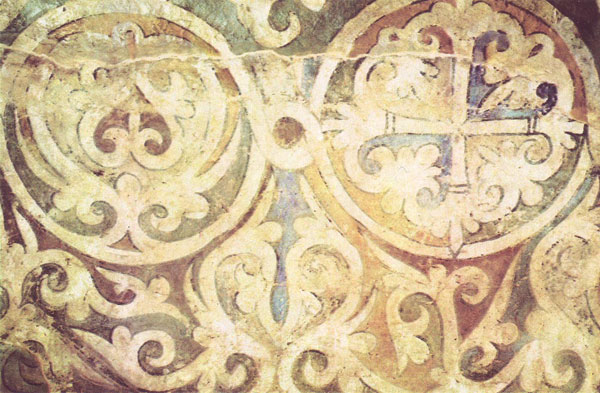ua. ru. en.
Museum ST. SOPHIA CATHEDRAL
Historical information
Plan of museum
ST. SOPHIA CATHEDRAL
Narthex
Architecture and murals
- Plan, Ground floor
- Mosaics
- Frescos
- Graffiti
- other details
Sarcophagus of Yaroslav the Wise
North cloister
Towers
Lofts
- Plan, First floor
ARCHITECTURAL MONUMENTS OF THE 18TH CENTURY
Bell Tower
Seminary
Cells of the Cathedral Elders
Metropolitan's Residence
Refectory
Consistory
South Entrance Tower
Zaborovsky Gate
First Rus library
BRANCHES OF THE MUSEUM
|
|
Excursions Kiev
weekend in Kiev
trip to Kiev
Excursions
tours to Kiev
Sights of Kiev
St. SOFIA CATHEDRAL
Mosaics and frescoes of St. Saint Sofia Cathedral IN KIEV
The Saint Sofia Cathedral, which Yaroslav the Wise, the Grand Prince of Kiev and Kiev Rus, founded in ³ 1037, has preserved not only the opulence of ancient architecture but also the pictorial decor of the 11th century. The St. Sofia Cathedral harmoniously combines two forms of monumental art — mosaics and frescoes. Some 260 square metres of mosaics decorate the main parts of the interior, that is, the central cupola and the chancel. The walls of the five aisles, the lofts, and both staircase towers are covered with 3,000 square metres of fresco painting dating back to the 11th century.

The arrangement of the paintings and the choice of the subject matter serve a definite ideological purpose arising from the Sofia Cathedral's significance as the principal temple of the Old Rus feudal state. Dedicated to the Holy Wisdom, the St. Sofia Cathedral, its architecture and decor asserted both the omnipotence of the Christian faith and the power of feudal rule. The all-important religious and secular ideas of the period found their expression in the artistic design of the Sofia Cathedral in Kiev and became a leitmotif of the entire system of the artistic decor.
The mosaics of the central cupola and the chancel of the St. Sofia Cathedral represent the main personages and scenes from the Gospel. The golden background accentuates the dazzlingly bright colours of the images. The mosaics of the Sofia Cathedral run in 177 colour hues. The mosaicists, whose names are unknown, had a perfect command of the rich set of colours.
A medallion in the summit of the central cupola of the Sofia Church bears a huge half-length figure of Christ Pantocrator. Arranged around him were four archangels. Of these only one mosaic figure in blue apparel remained intact. The artist Mikhail Vrubel restored the three others with oil paints in 1884.
Christ Pantocrator. Central cupola:
Of the twelve mosaic portraits of the Apostles in the interfenestra-tions of the cupola only the upper part of the figure of St. Paul has survived. Represented on the spherical pendentives supporting the central dome are the figures of the four Evangelists of whom the figure of St. Mark has been preserved. Fifteen mosaic medallions of the Sebastian Martyrs have survived on the wall arches. The two piers of the eastern arch of the Sofia Cathedral feature The Annunciation (on the left is Archangel Gabriel, and on the right the Virgin Mary).
A magnificent ensemble of mosaics decorates the chancel of the Sofia Kievskaya. The vault of the central apse is dominated by the majestic monumental figure of the Virgin Orans. The combination of the blue colour of her garments and the warm golden background is characteristic of the entire colouristic design of the St. Sofia Cathedral's decor. The multi-figure composition The Eucharist spreads over a large area in the intermediate tier of the apse.
the Virgin Orans, Sofia Cathedral:
The symbolic scene of the Apostles receiving Communion reveals the principal dogma of the Christian religion. The frescoes in the nave, transept and lofts of the Sofia Saint Cathedral are closely related to this subject.
The lower tier of the apse features the figure of the Church Fathers (of whom but the upper parts have survived info modern times). These are real masterpieces of psychological portraiture.
The mosaics of all the three tiers of the chancel of the St. Sofia Cathedral form a compositional and colouristic whole. The white omophores of the Church Fathers are in keeping with the light-coloured garments of the Apostles in The Eucharist, while the blue apparel of the Mother of God and of Christ matches with the background of the ornaments above the Church Fathers. The blue and white tones in the apse are accentuated by the crimson colour of the Communion table in the centre of The Eucharist scene.
The decor in the chancel of the Sofia Kiev Cathedral is a fine example of the synthesis of architecture and painting, typical of the Sofia Cathedral's interior in general. The mosaic scenes and images not only symbolize the basic principles of the Christian doctrine, but also serve as an epigraph to the subsequent pictorial narration conveyed in fresco painting. The frescoes of the transept depict evangelical scenes. The best preserved among them are: Crucifixion, The Descent of Christ info Hell, Christ Appears to the Women Bearing Spicies, as well as the scene The Descension of the Holy Ghost which is remarkable for its composition and original manner of execution and colouratin.
fresco Christ's Descent into Hell. Transept. North section:
The lofts of the Sofia Kievskaya Cathedral feature such evangelical and biblical subjects as The Miracle in Ñanà, The Miracle of the Loaves and Fishes, The Last Supper, Abraham Meets the Three Strangers, Abraham Entertaining the Angels, Abraham Offers Up Isaac, and The Three Youths in the Fiery Furnace.
Abraham Meets the Three Strangers:
An interesting cycle of frescoes, which are compositionally reminiscent of ancient miniatures, has survived in the chapels and the aisles of the St. Sofia Cathedral. Here, scenes from the lives of saints are painted in chronological sequence in each tier. The subjects are treated in a true-to-life manner. The saints have Iively, expressive faces, their poses are natural, and their gestures dynamic. The sadly lyrical image of Anna (Anna's Invocation), The Visitation of Mary and Elizabeth, the touching figure of the little Mary in The Presentation of Mary in the Temple and other scenes convey profound emotionality. On the walls, cruciform piers and arches of the St. Sofia Cathedral are numerous figures and half-length portraits of saints. The ancient masters created a gallery of striking images. Paying special attention to facial features, the artists conveyed all shades of expression — severity, grandeur, sublimity, ascetism, fanaticism and youthful softhess.
Fresco Kissing Mary and Elizabeth. Detail.
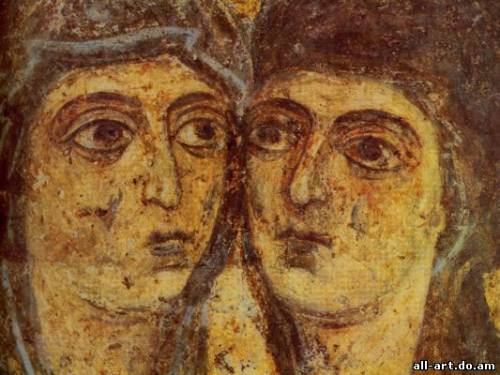
The northern lateral chapel of the Sofia Cathedral is dedicated to St. George, the patron saint of Yaroslav the Wise (the Prince's Christian name was George). The frescoes of the southern lateral chapel portray the feats of Archangel Michael who was considered the patron of the Prince's bodyguards and of Kiev. Herein lies the direct link between religious and secular images, the latter occupying a significant place in the decor of the Santa Sofia Cathedral.
The principal secular composition in the Sofia Cathedral was the group portrait of Yaroslav the Wise's family which was painted on three walls of the nave opposite the chancel. It represented the entrance of the Prince, his wife Irene, his daughters, who later became queens of France, Norway and Hungary, and his sons, who became renowned political figures of Old Rus state in the latter half of the 11th century. Yaroslav the Wise was portrayed with a model of the Sofia Church, which he founded. All that remains now of the large composition is but a part of the portraits of the Prince's sons and daughters.
Portrait of family of Yaroslav the Wise. Theoretical reconstruction:
1. According to V. Lazarev: on the left of Christ-Princess Irene with daughters, on the right-Yaroslav the Wise with sons
2. According to S. Vysotsky: on Christ's left - Prince Vladimir and Prince Yaroslav with sons, on his right - Princess Olga and Princess Irene with daughters
3. According to A. Poppe: on the left of Christ - Prince Yaroslav with sons and a daughter, on the right - Princess Irene with daughters
Unique frescoes of secular character have been preserved on the walls and piers of the two staircase towers which led to the Prince's compartments in the lofts. They depict hunting scenes, figures of acrobats, musicians, dancers, wrestlers, horsemen, and the like. A large space is occupied by the Hippo drome composition in the southern tower. It features quadrigae, the masters of ceremonies giving the start signal for the races, the speeding chariots, and the hippodrome grandstand seating the Byzantine Emperor and his numerous guests.
Hippodrome. Reconstructed by A. Radchenko:
Hippodrome. Details:
Pictures of beasts (cheetah, lion, bear, camel, ass, wild boar, dog, hare), birds and fantastic creatures frequently appear in the frescoes of the Sofievskiy Cathedral. Of great interest are the figures of buffoons with musical instruments: a musician with a bow instrument sifting on a roadside stone, flutists and other musicians playing on psalteries and lutes. The only picture of the pipe organ known in Old Rus art is depicted in the southern tower. One can easily discern the organ, the organist striking the keys, and the two men pumping air into the pipes with bellows.
Organ in the picture Buffoons Reconstructed by S. Vysotsky and I. Totskaya:
Buffoons. Details:
The tower frescoes of the St. Sofia Cathedral provide us with an interesting insight into the life and mores of the princely court of those times. This is the only collection of monumental genre painting that has come down to us from the heyday of Old Rus (Kiev Rus) state.
The ornament adorning the window openings and doorways of the Saint Sofia Cathedral are also important components of the interior decor. They frame certain fresco and mosaic compositions and accentuate the main architectural lines of the interior. In most cases they are of floral nature and consist of stylized palmettoes, vine sprouts, tendrils and buds. Geometric patterns are rare. Colourful and elegant, the ornaments also introduce secular features into the interior system of decor of the St. Sofia Cathedral.
Frescoes were also widely used in decorating the fronts of the Sofia Cathedral in Kiev. The craftsmen painted bright red bands to underline all the projections of the niches, arches, and other architectural elements on the fronts. They placed pictures in many niches and decorated the outsides of the window openings and doorways with tracery. Covered with frescoes, the open galleries (later immured) engirdled the edifice with a richly coloured band. At present, there is a rather bright fresco with lush floral ornament in a niche on the western front, which are suggestive of the magnificent decor of the past.
Numerous Slavic graffiti, which help to establish the dates of the frescoes, have been preserved on the walls of the Sofia Cathedral. Apparently, the frescoes in the central part of the Sofia Cathedral were executed in the 1040s, and in the galleries in 1060s. More about Graffiti >>>
Throughout the centuries the Sofia Cathedral and its interior decor were subjected to destruction, renewals, and alterations. At the turn of the 18th century the Sofia Cathedral went through a capital repair. The murals on its walls were covered with plaster and adorned with new compositions in oils. With time the existence of the once colourful frescoes faded into oblivion. It was only in the 19th century that they were occasionally discovered, and in the 1840s and 1850s given a modern touch. Ever since the State Museum of St. Sofia Cathedral was organized in 1934, extensive restoration work has been carried out. The ancient mosaics and frescoes have been cleaned and fixed securely in place. Today, the interior decor has been completely freed from the layers of plaster and paint of later date. The frescoes and mosaics were restored only in those places where the initial decor had been completely destroyed. As a result; an incomparably beautiful and orderly collection of 11th-century paintings has been opened to the view of our contemporaries.
The highly consummate mosaics and frescoes of the Sofia Cathedral are characterized by clarity and laconicism of artistic expression, profound emotional impact, decorative beauty, compositional and colouristic integrity, the finesse of artistic conception.
The traditions of Kiev Rus monumentalists were promoted by the Old Rus craftsmen of later generation. These traditions live on in the works of Andrei Rublev and Dionysius, in the murals of Novgorod and Pskov, in ancient Ukrainian icons and wooden churches, and in the ensemble of the Moscow Kremlin.
The mosaic and frescoes of St. Sofia Cathedral in Kiev are an outstanding example of medieval monumental art. Together with the famous architectural masterpieces in Ravenna, Venice, Monreale, Daphni, Palermo and Constantinople, they occupy an eminent place in the treasure-house of world art.
Chancel of St. Sofia Cathedral
Story about St. Sofia Cathedral in Kiev photo description, mosaics, murals, graffiti, paintings, Sofia Reserve
Read more:
- St. Sofia Cathedral History
- Mosaics
- Frescos
- Graffiti
- Other Details of the interior of the St. Sofia Cathedral
- ARCHITECTURAL MONUMENTS on the reservation territory St. Sofia Cathedral
 Mosaics and frescoes of St. Sophia Cathedral IN KIEV
Mosaics and frescoes of St. Sophia Cathedral IN KIEV
Virtual tour around the museum’s grounds of Saint Sophia Cathedral
National Historical Reserve "St. Sophia Cathedral in Kiev"
Address: Vladimirskaya Str. 24, Kiev Ukraine
Underground station "Golden Gate".
Hours: 10:00 - 17.30
Closed: Thursday
